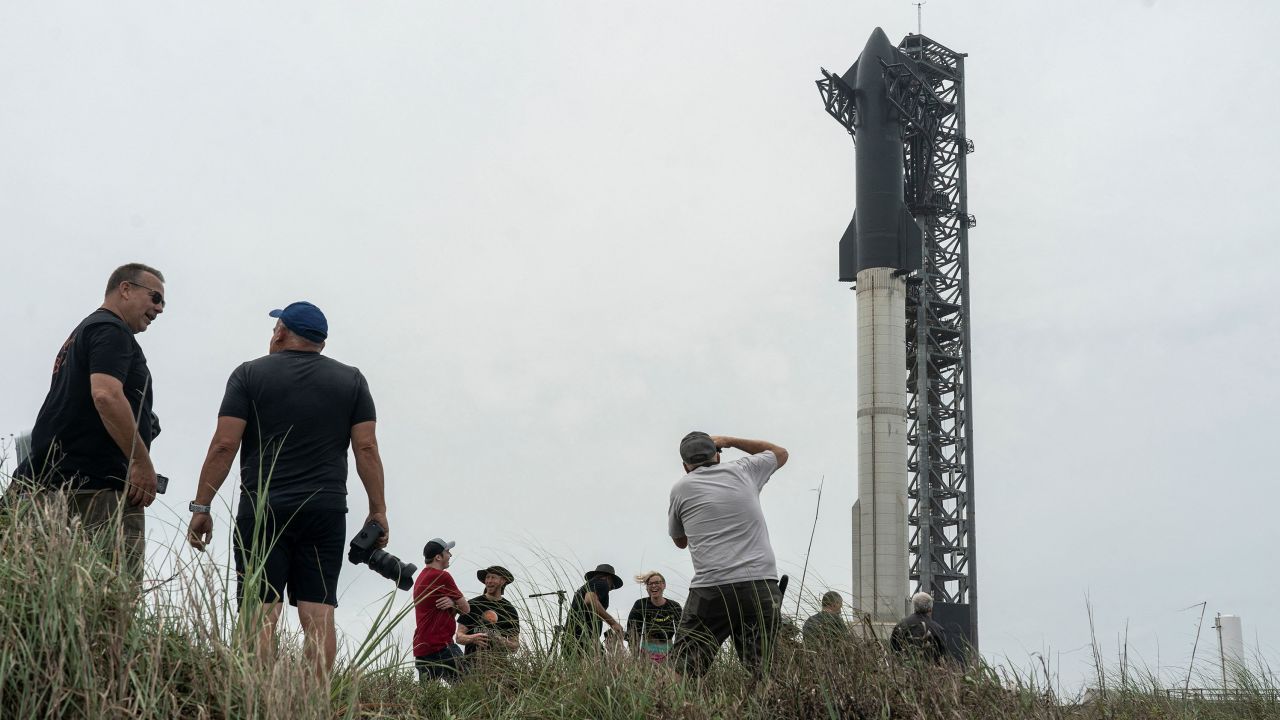
Just a few months after NASA introduced the world to the most powerful rocket ever flown to orbit, Elon Musk’s SpaceX is prepared to set off its own creation — which could pack nearly twice the power of anything flown before.
SpaceX’s vehicle, called Starship, is currently sitting on a launch pad at the company’s facilities on the southern Texas coastline. The company is targeting liftoff at 8 a.m. CT (9 a.m. ET) on Monday, although it has the ability to take off anytime between 8 a.m. CT (9 a.m. ET) and 9:30 a.m. CT (10:30 a.m. ET).
“I guess I’d like to just set expectations low,” SpaceX CEO Elon Musk said during a Twitter “Spaces” event for his subscribers Sunday evening. “If we get far enough away from launch pad before something goes wrong, then I think I would consider that to be a success. Just don’t blow up the pad.”
He added: “There’s a good chance that it gets postponed since we’re going to be pretty careful about this launch.”
It will be SpaceX’s first attempt to launch a fully assembled Starship vehicle, building on a years-long testing campaign.
Musk has talked about Starship — making elaborate presentations about its design and purpose — for half a decade, and he frequently harps on its potential for carrying cargo and humans to Mars. Musk has even said that his sole purpose for founding SpaceX was to develop a vehicle like Starship that could establish a human settlement on Mars.
Additionally, NASA has already awarded SpaceX contracts and options worth several billions of dollars to use Starship to ferry government astronauts to the surface of the moon under the space agency’s Artemis program.

The inaugural flight test will not complete a full orbit around Earth. If successful, however, it will travel about 150 miles above Earth’s surface, well into altitudes deemed to be outer space.
Starship consists of two parts: the Super Heavy booster, a gargantuan rocket that houses 33 engines, and the Starship spacecraft, which sits atop the booster during launch and is designed to break away after the booster expends its fuel to finish the mission.
The massive Super Heavy rocket booster will give the first blast of power at liftoff.
Less than three minutes after takeoff, it’s expected to expend its fuel and separate from the Starship spacecraft, leaving the booster to be discarded in the ocean. The Starship will use its own six engines, blazing for more than six minutes, to propel itself to nearly orbital speeds.
The vehicle will then complete a partial lap of the planet, reentering the Earth’s atmosphere near Hawaii. It’s expected to splash down off the coast about an hour and a half after liftoff.
What’s riding on this launch
Starship’s ultimate success or failure immensely consequential. Not only is it crucial to SpaceX’s future as a company — it also underpins the United States government’s ambitions for human exploration.
But it’s not all riding on this inaugural test flight. SpaceX has long established its willingness to embrace mishaps, mistakes and explosions in the name of refining the design of its spacecraft.
In the lead-up to the first launch of the company’s Falcon Heavy rocket in 2018, which held the title of most powerful rocket before NASA’s SLS took flight last year, Musk foresaw only a 50-50 chance of success.
“People (came) from all around the world to see what will either be a great rocket launch or the best fireworks display they’ve ever seen,” Musk told CNN at the time.
The inaugural Falcon Heavy launch was ultimately successful.
Getting here
Development of Starship has been based at SpaceX’s privately held spaceport about 40 minutes outside Brownsville, Texas, on the US-Mexico border. Testing began years ago with brief “hop tests” of early spacecraft prototypes. The company began with brief flights that lifted a few dozen feet off the ground before evolving to high-altitude flights, most of which resulted in dramatic explosions as the company attempted to land them upright.
One suborbital flight test in May 2021, however, ended in success.

Since then, SpaceX has also been working to get its Super Heavy booster prepared for flight. The massive, 230-foot-tall (69-meter-tall) cylinder is packed with 33 of the company’s Raptor engines.
Fully stacked, Starship and Super Heavy stand about 400 feet (120 meters) tall.
SpaceX has been waiting more than a year to get FAA approval for this launch attempt.
The company, and federal regulators tasked with certifying SpaceX launches won’t pose risks to people or property in the area surrounding the launch site, have faced significant pushback from the local community, including from environmental groups.
But the Federal Aviation Administration, which licenses commercial rocket launches, announced Friday, April 14, that it granted the company’s request for an uncrewed flight test of the rocket out of the SpaceX facilities in South Texas.
“After a comprehensive license evaluation process, the FAA determined SpaceX met all safety, environmental, policy, payload, airspace integration and financial responsibility requirements,” the agency said in a statement.
During a call with reporters last week, an FAA official, who declined to be named for publication, said that the agency has been overseeing SpaceX’s compliance with the mitigating actions, some of which are still in the works, even as the company prepares for launch.
The FAA official said government personnel will be on the ground to ensure SpaceX complies with its license during the test launch.
NASA and the future of Starship
SpaceX’s contract with NASA to use Starship for the space agency’s Artemis III moon landing later this decade leaves much of Starship’s development work to SpaceX. A $2.9 billion deal, inked in April 2021, was awarded to SpaceX over several competitors. It was later expanded to include a second lunar landing mission in 2027.
NASA has been working over the past year to hash out a work flow between the space agency and SpaceX. It’s a dynamic the two organization have had to iron out in previous SpaceX-NASA projects, including an ongoing partnership that uses SpaceX’s Dragon spacecraft to get astronauts to and from the International Space Station.
A moon mission, however, involves more powerful and complex hardware.
NASA is not, however, involved in planning the flight profile for this test flight or directing SpaceX on what to do, according to Lisa Hammond, NASA’s associate program manager of the Human Landing System at Johnson Space Center in Houston.
Hammond did not share a specific checklist of tests or flights that NASA hopes to see before Starship is entrusted with a moon landing mission.
“I would not put it with a number,” she said, adding that the Artemis II mission, slated for next year, will see humans fly atop the SLS rocket after only one uncrewed test flight.
“The confidence comes in the design, the confidence comes in the safety of the vehicle for the crew,” Hammond said.
SpaceX president Gwynne Shotwell previously said she hopes the company will conduct more than 100 orbital test flights of Starship before putting humans on board, as the company will need to do in order to help NASA carry out its moon landing with the Artemis III mission, slated for 2025.
“I think that would be a great goal,” Shotwell said Wednesday, when asked whether that target was still feasible. “I don’t think we will do 100 flights of Starship next year, but maybe (in) 2025 we will do 100 flights.”
NASA’s current timeline targets 2025 for the first lunar landing mission, which will see astronauts transfer from their Orion capsule, which will launch atop a NASA Space Launch System rocket, and into a Starship spacecraft already in lunar orbit. It will be the Starship vehicle that ferries the crew down to the lunar surface.
It’s not clear, however, if 2025 is feasible. NASA’s inspector general has already suggested it is not. Delays, according to comments from the inspector general in March 2022, could revolve around Starship.




